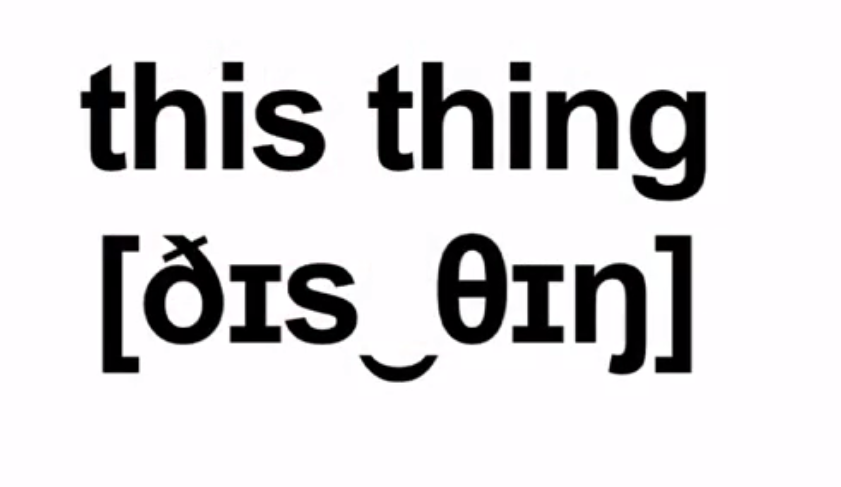(单词翻译:单击)
In this American English pronunciation video, we're going to talk about linking and the TH sound.
在这个美式英语发音视频中,我们来讨论一下连读和TH音。
I've been getting a lot of questions about this recently.
最近我收到了很多关于这个的问题。
Understandable, since the TH sound is in some very common words, and linking is such an important concept in American English.
这是可以理解的,因为TH音在很多单词里都很常见,而连读在美式英语里也是一个很重要的概念。
Of course, I can't go over every combination of linking with the TH.But in this video, we're going to take 10 examples.
当然,我不可能讲解每个带有TH音的连读组合。但是在这个视频里,我们会举10个例子。
We'll watch them in slow motion, and we'll discuss what the mouth is doing to link the sounds.
我们将会看这些例子的慢动作,并且讨论在连读这些单词时嘴应该怎样做。
Let's get started."This thing."Here we're linking the S with the TH.
让我们开始吧。"This thing."这里是S音和TH音的连读。

Here the tongue comes through for the first TH sound, tongue tip stays just behind the bottom teeth as they come together for the S, and the tongue comes through again for the TH.
在这里,第一个TH音时舌头穿过上下两排牙齿,S音结束后牙齿合上时舌头停留在下排牙齿后面,然后在第二个TH音时舌头再次穿过牙齿。
So the movement from the S to the TH is quite simple.
因此,这个从S音到TH音的动作十分简单。
Teeth go from being closed, with the tongue just behind the bottom teeth to parting with the tongue coming through.
一开始牙齿是合着的,然后舌头停在下排牙齿后面,最后舌头再穿过牙齿。
Let's watch again."This thing."Here we're linking the Z with the voiced TH."Was that."
让我们再看一遍。"This thing."这里是Z音和TH音的连读。"Was that."
Even though the sounds are different than the previous example, the mouth position is the same for both sounds.
即使这个音和先前的例子不同,嘴型都是相同的。
However, in this case there's going to be a difference.
然而,在这个情况下会有一点区别。
Teeth close for the Z sound, but the tongue tip doesn't really come through the teeth for the TH.
发Z音时牙齿合上,但在发TH音时舌尖并没有完全穿过牙齿。
That's because you can get away with making the voiced TH sound, especially at the beginning of an unstressed syllable, by pressing the tongue behind the closed teeth.
这是因为在读发音的TH音时,尤其是在非重读音节之前,将舌尖放在合上的牙齿之后也是可以的。
So, the tongue tip will press behind where the teeth come together, but not actually come all the way through like it does for the unvoiced TH.
因此,舌尖要放在合上的牙齿之后,但并不像发音的TH音一样完全穿过牙齿。
Let's watch again."Was that."Here I'm linking a stop T with the voiced TH.Something interesting happens here."Sit there."
让我们再看一遍。"Was that."这里是顿音T和发音的TH音连读。这里发生了一些有趣的事情。"Sit there."
Rather than the tongue going up into the stop T position, it simply comes out of the vowel, straight into the TH position.
舌头并没有到达顿音T的位置,而是在元音结束后直接到达了TH音的位置。
However, I don't leave the stop T out. I still stop the sound before voicing the TH -- "sit there, sit there" -- so that we get the feel for the stop T.
然而,我没有把顿音T省略。我在发TH音之前会停顿——"sit there, sit there"——这样就有了顿音T的感觉。
But rather than taking the tongue tip to the roof of the mouth, I make the stop while bringing the tongue tip through the teeth.
但是我没有把舌尖放到上颚,我是在舌尖位于牙齿之间时停顿。
Let's watch again."Sit there."Here we're linking the V sound with the voiced TH.It's quite straightforward.
让我们再看一遍。"Sit there."这里是V音和发音的TH音连读。它十分简单。
You will clearly see both mouth positions."Of these."Let's watch again.
你会清晰地看到发两个音时的嘴型。"Of these."让我们再看一遍。
The bottom lip comes up making contact with the top teeth for the V sound, then the lip pulls down and the tongue comes through the teeth for the TH sound.
发V音时,下唇要与上排牙齿接触,然后下唇放松,舌头穿过牙齿,发出TH音。
"Of these."Here we're linking the P with the voiced TH.Again, it's quite straightforward.You'll clearly see the mouth position of both sounds.
"Of these."这里是P音和发音的TH音连读。同样,它也十分简单。你会清晰地看到发两个音时的嘴型。
"Hope the."The lips come together to make the P, and as they part, the tongue tip comes through the teeth to make the TH.
"Hope the."双唇接触,发出P音,当它们分开时,舌尖穿过牙齿,发出TH音。
Watch again."Hope the."Here we're linking the unvoiced TH with the ST consonant cluster."North star."
再看一遍。"Hope the."这里是不发音的TH音与ST辅音集群的连读。"North star."
The tongue comes through the teeth, to make the TH.
舌头穿过牙齿,发出TH音。
Then the tongue tip pulls back and touches just behind the bottom of the front teeth while the teeth close to make the S sound.
然后舌尖收回,在牙齿合上时碰到前排牙齿的下端,发出S音。
Then the tongue tip will go up to the roof of the mouth to make the T.Let's watch again."North star."
然后舌尖向上颚移动,发出T音。让我们再看一遍。"North star."
Here we're connecting the unvoiced TH with the F consonant.You'll be able to clearly see both mouth positions."With funny."
这里是不发音的TH音和辅音F连读。你会清晰地看到发两个音时的嘴型。"With funny."
Tongue comes through the teeth for the TH, and the bottom lip raises to touch the bottom of the front top teeth for the F sound.
舌头穿过牙齿,发出TH音,然后下唇接触上排牙齿的下端,发出F音。
Watch again."With funny."Here we're connecting the unvoiced TH with the W consonant sound."Both will."
再看一遍。"With funny."这里是不发音的TH音与辅音W连读。"Both will."
Tongue comes through the teeth for the TH, then pulls back and the lips form the tight circle for the W while the tongue tip is just behind the bottom front teeth.
舌头穿过牙齿,发出TH音,然后收回舌头,发W音时,双唇形成一个圆形,舌尖刚好在上排牙齿的下端。
Watch again."Both will."Here we'll see the unvoiced TH linking to the K consonant sound."Health code."
再看一遍。"Both will."这里是不发音的TH音与辅音K连读。"Health code."
Tongue tip comes through the teeth for the TH.
舌尖穿过牙齿,发出TH音。
For the K, the tongue tip comes back in the mouth and goes down, touching behind the bottom front teeth.
发K音时,舌尖移动到嘴的后面,并且向下接触上排牙齿的下端。
The back part of the tongue raises and touches the soft palate, which is why you see a dark space in the mouth.
舌根部分抬起,接触软腭,这就是你在嘴里看到一部分黑色的原因。
Watch again."Health code."Here we'll see the unvoiced TH linking with the S sound."South side."
再看一遍。"Health code."这里是不发音的TH音与S音连读。"South side."
Tongue tip comes through the teeth for the TH.Watch again."South side."
舌尖穿过牙齿,发出TH音。再看一遍。"South side."
Then the tongue tip comes back into the mouth and lightly touches behind the bottom front teeth while the teeth close to make the S sound.
然后舌尖收回,稍抵上排牙齿的下端,牙齿合上,发出S音。
I hope this study in linking words with the TH will make it easy for you to link any word with the TH that you may come across.
我希望这次关于TH连读的学习会使你在遇到任何与TH连读的单词时更轻松一些。
Practice word pairs like the 10 here, or other word pairs, and do them slowly. And practice them over and over.
练习这10个词组,或是其他词组,慢慢来练习。一遍又一遍地练习。
Repetition really will help you become more comfortable linking with the TH sound.
反复练习真的会帮助你更习惯带有TH音的连读。
That's it, and thanks so much for using Rachel's English.
这次的学习就到这里,非常感谢使用Rachel's English。


